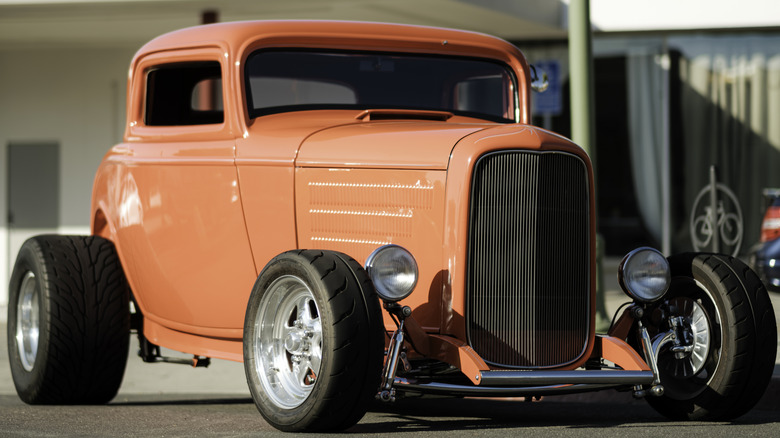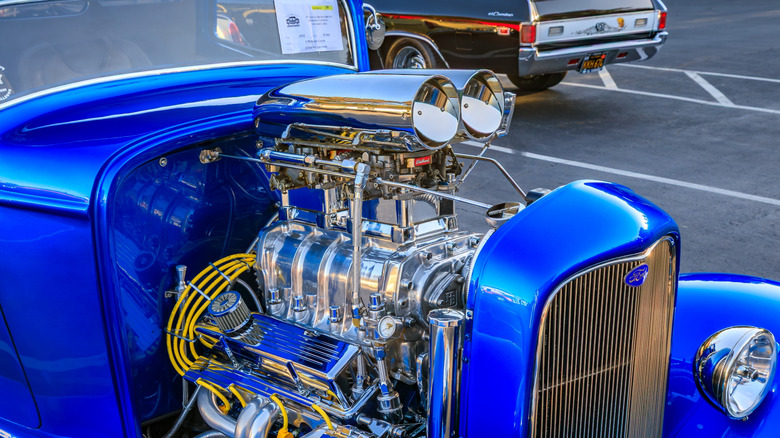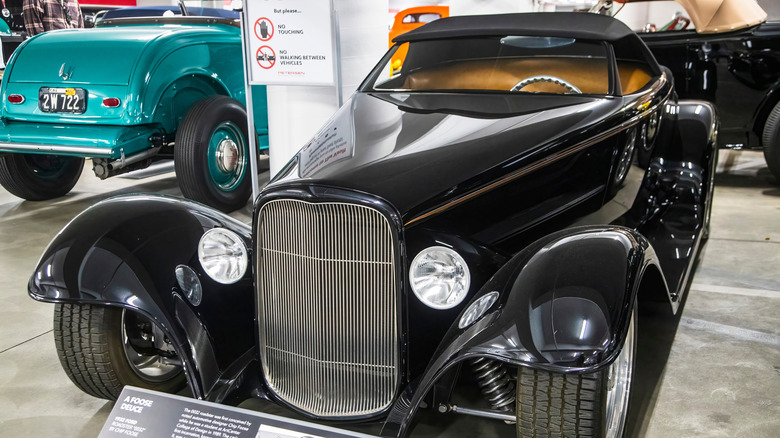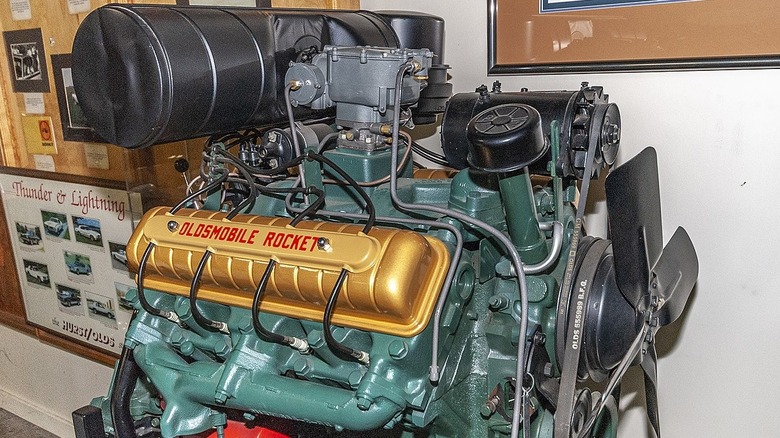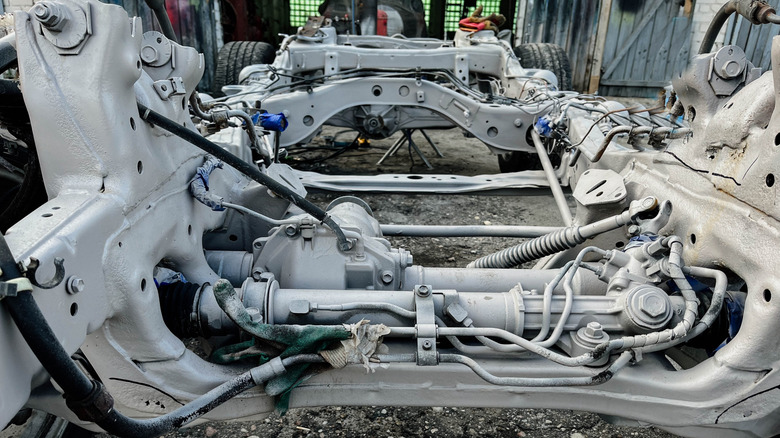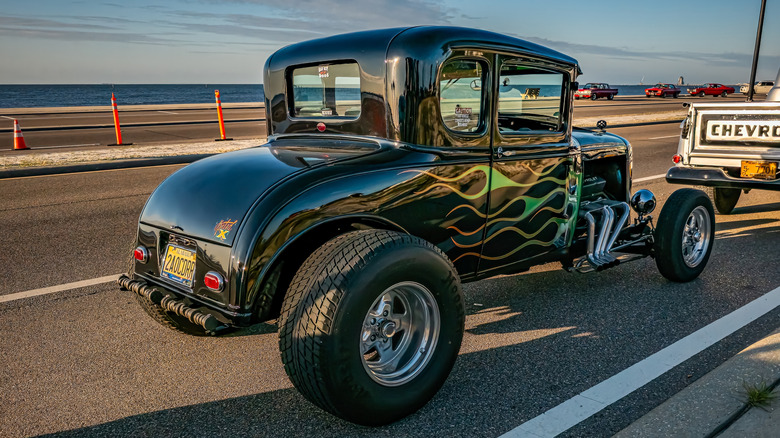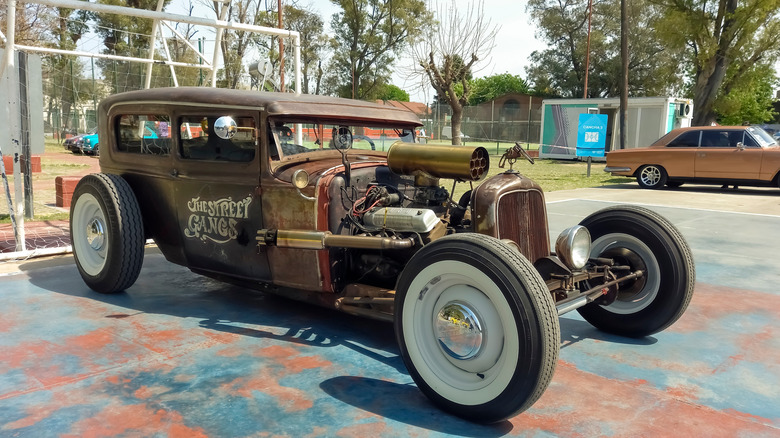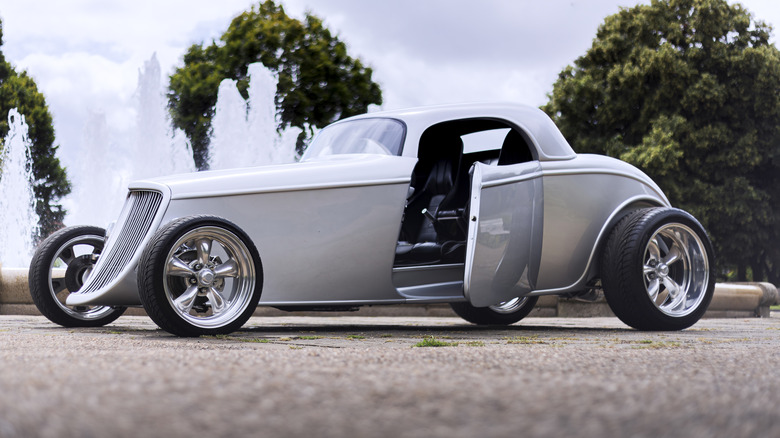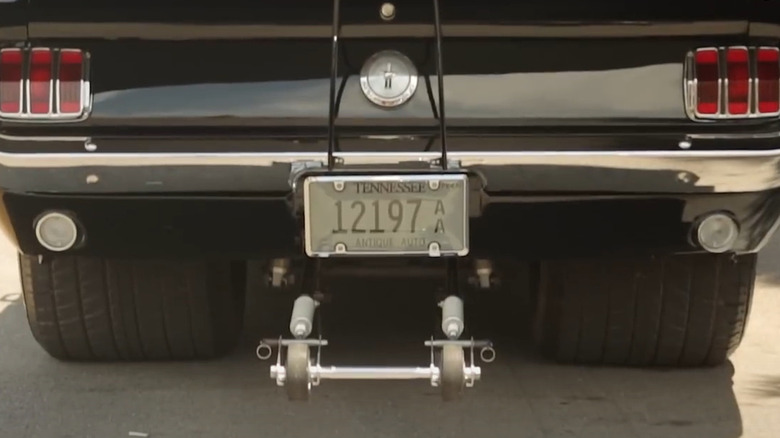9 Common Hot Rod Terms And What They Mean
Some of the very first self-propelled vehicles were products of engineers and the curious in private garages and workshops. Within a few decades of the invention of the first car, companies were mass-producing them, bringing horseless transportation to the masses. Almost immediately, those same at-home tinkerers began modifying factory-made vehicles in the name of purpose, performance, or pure expression.
In the century since, automobiles have come to exist at the center of a triple Venn diagram of art, engineering, and utility. From the barest-bones grunt pickup truck to the latest feat of engineering to come out of Bugatti in the Tourbillon, they hold a place in the hearts of millions, for millions of reasons.
One of the earliest and most fondly remembered, not to mention emulated, forms of car modification is hot rodding. It began in the 1920s and 1930s when speed-addicted youngsters began chopping up and rebuilding their Model T and Model A Fords. The hobby spread from southern California across the nation, and well beyond the Blue Oval's products.
Throughout the '40s, '50s, and beyond, the trend picked up speed, and like many hobbies with a large and passionate fanbase, it developed its own vernacular. Nowadays, listening to a car guy talk about what he's done to his car can sound like a foreign language to the uninitiated, but we're here to help.
In this guide to common hot rod terms, we'll explain the origin and meaning of some of the language this community often uses.
Blown/blower
Speaking of superchargers, the term blown or blower gets bandied around quite a bit in the hot rodding community. It might seem a little inappropriate or tragic to those not in the know, but referring to a blown engine doesn't mean that particular engine has blown up (though it can mean that — context matters). It means the engine has a supercharger.
Cars need two things above all else to run: fuel and air. Getting that fuel and air mixed just right, lighting it, and channeling the resulting explosion has been the passion and pursuit of engineers and mechanics for decades. One way to increase the amount of air involved in the explosion is via a device known as a supercharger, not to be confused with a turbocharger.
By cramming more air into the combustion chamber of an engine, superchargers allow for a larger amount of fuel, while retaining a proper fuel-to-air ratio. Combining more fuel with more air equals more boom. More boom equals more go, and more go is a very good thing in the hot rod community. Superchargers are compressors that force a larger amount of air into an engine than it would otherwise breathe on its own. By simplifying it down to its barest characteristics, hot rod fans refer to superchargers simply as blowers, because they blow air. A blown engine has a supercharger attached.
Chopped
The term chop doesn't have great connotations. After all, no one wants their beloved jalopy dismantled in a chop shop — where thieves take cars to part them out. However, the right type of person might enjoy having a chopped hot rod.
One of the earliest modifications hot rodders made to factory cars was to change their body lines. There were multiple ways of doing this, from modifying or adjusting the suspension to alter the stance to channeling, or lowering the body and raising the floorboards. Changes to the vehicle's profile could also change how air flows over the body.
Chopping a car was a popular way to alter its factory appearance — you've probably already seen more than one chopped hot rod, even if you didn't know what you were looking at. A chopped hot rod has had its roof lowered by cutting -– or chopping -– out the A-pillars and modifying the windshield to fit into the smaller space.
Some hot rodders build a car's entire identity around the chopped roof. The lower the profile, the meaner the look, or so the theory goes. Not to mention less real estate to catches air like a sail. All the better for racing those accursed Scorpions from the other side of the tracks.
Crate engine
Car enthusiasts' forums are often filled with detailed (and sometimes heated) debates about the best engine for your setup. While the answer is a blend of opinion, specs, and price points, most agree that a crate motor offers significant potential. But what exactly is a crate motor or engine? Simply put, it's a fully prepared engine that's ready to be installed.
While plenty of grease monkeys revel in going elbow-deep in their favorite vintage engine block, some prefer getting a crate engine — a fully prepared engine with all the work done for you — and dropping that puppy in the engine bay.
Crate engines come in a wide variety of shapes and sizes, catering to different preferences and needs. From the powerful big-block 427 to the efficient four-cylinder, there's a crate engine for every project.
Several aftermarket companies even offer custom-built crate engines tailored to specific models and makes, allowing for a truly personalized experience. And the best part? It all arrives in a crate, ready to go, in as little as a few weeks.
Frame-off
Rebuilding a hot rod to your tastes can be a seriously in-depth process, and there are two ways to approach an involved customizing job: frame-up and frame-off restoration. A frame-up restoration essentially leaves the car as-is (pending the removal of certain parts, of course) — generally acceptable for vehicles with minimal rust damage. However, getting down to the nitty-gritty and building a hot rod from the ground up will require a frame-off restoration.
Doing a frame-off restoration represents a serious commitment of time and money. Many shops estimate an additional 200 to 400 work-hours to perform one. It involves removing the body from the car's frame (often, for the first time since the factory put them together) and then going over both with a fine-toothed comb. The process usually includes sandblasting, welding, and vigorous inspection before refinishing the frame with element-resistant primers, patching up any imperfections in the body, and rejoining the two in holy matrimony. Then it's time to worry about the rest of the car.
Hot rod
Even people with little interest in cars could tell you that a hot rod is a car that has been modified, usually for performance. Someone in the know could explain that it stems from early American modifiers rebuilding factory cars at home, often beefing up V8s and adding aesthetic flair that makes the car stand out. But where exactly did that term, hot rod, come from? Nobody is actually 100% sure, though there are theories and educated guesses. Like many slang terms, its origins are somewhat amorphous. Merriam-Webster says it's "an automobile rebuilt of modified for high speed and fast acceleration." While that's surely true, not everyone would consider most of the entries on our list of the coolest restomods ever built to be true hot rods.
One theory is that the term came from refitting a stolen — or hot — car with a new paint job and engine. Another posits that fitting a Ford Flathead V8 with a hotter cam might have brought the nomenclature into use. Yet another idea reverse engineers the term into hot roadster — as in "say, that's one hot roadster you have there."
In practice, "hot rod" can be used as broad as referring to any fast or powerful car, or as limited as using it only for the early Ford and Chevy cars that helped originate the term. Whatever the truth, hot rod culture has permeated the automaking zeitgeist and brought with it an entire dictionary of slang terms.
Rat rod
Today, the cost of building a hot rod can soar into the hundreds of thousands, but the original spirit of hot rodding was rooted in affordability. It was about DIYers gathering in the garage with a some buds and suds, not about the custom-built body and brand-new crate engine that only a few could afford.
For a while, hot rodding seemed to be drifting towards the realm of the wealthy, with museum-minded millionaires investing heavily to create the shiniest and prettiest specimens. This is where rat-rodders stepped in, countering the trend with an attitude that embraced the rougher side of things.
Reportedly, the term "rat rodding" has its roots in the motorcycle world, where a cheaply made custom motorcycle was referred to as a rat bike. According to Hot Rod Magazine (and who would know better?), auto journalist Gary Baskerville is credited with co-opting the term for the modern car rat-rodding trend that emerged around 25 years ago.
Rat rodding has since evolved into a genre that stands in stark contrast to the traditional hot rod. While a hot rod is often a gleaming work of art polished to a high sheen with nary an aesthetic detail missed, a rat rod revels in raunchy rebellion. It's a celebration of imperfection, with some rat rods being virtually indistinguishable from the junkyard heaps from which their parts came. And that's just the way rat rodders like it — a bit rough around the edges, with oodles of character and attitude.
Resto mod
Resto-modding, a relatively recent trend in auto building, strikes a delicate balance between modernity and tradition. While not all hot rods are resto-mods, they certainly can be. Resto modding, a shortened form of restoration modification, is essentially about bringing an old car (such as a hot rod) up to modern standards technologically, all the while preserving its vintage charm.
Resto-modding modifications can include virtually every system on a car. For instance, the safety equipment can be upgraded to include modern airbags. The brakes can be replaced with more efficient disc brakes. The fuel management systems can be updated to electronic fuel injection. These upgrades bring the car up to modern standards, while retaining some of the old-school charm.
Hot rods can be resto-mods, but so can virtually any vintage car. Even rust buckets that seem beyond repair, like tri-five Chevies and Ford Model As and Model Ts (some of the original hot rods), have been transformed with the resto-modding treatment, yielding some truly inspiring results.
Proponents of the genre argue that resto-modding is the best of both worlds in terms of convenience and comfort combined with old-school charm. However, not every hot rodder will agree. Some argue that old technology is part of the fun of bringing a hot rod to life. Additionally, resto-modding can be complex and expensive, and it may not be suitable for all vintage cars.
Souped up
The term souped up goes hand-in-hand with hot rods, and its origins are just as mysterious. After all, how did no one's favorite food become synonymous with customized high-powered cars? The term goes beyond the car world. Just about anything that's modified to improve its performance, such as computers, motorcycles, or even kitchen appliances, lays a claim to having been souped up. It also has an entry in Merriam-Webster: "enhanced or increased in appeal, power, performance, or intensity."
Motor Trend put forth the possibility that the soup part is short for supercharger, which many hot rods have affixed to their engines, though it certainly isn't a requirement to have one to be considered a hot rod. There is also the possibility that the phrase, like many early auto terms, came from horse racing. A horse that has been injected with a so-called soup of performance enhancers could be considered souped up.
Hot rodding wasn't always the big business it is today. Perhaps souped up comes from early adopters having to innovate to secure and install the parts they needed for their cars, thus making it a soup of many ingredients.
Tubbing
Calling a car a tub usually means it's a big, boaty piece of junk. But tubbing a car is something altogether different. If there's one auto characteristic that most hot rods share, it's the need for big patches of rubber in the rear to transfer all of that asphalt-melting horsepower to the road. Sometimes, a vehicle even requires special modifications to accommodate drag-style tires.
The process of tubbing involves the removal of the inner sections of the rear wheel wells, creating space for an ultra-wide tire. The result is a vehicle that may appear unassuming from the side, but a rear view reveals a striking visual difference — the rear tires are much closer than a stock configuration would allow, giving the car a unique and powerful stance.
Tubbing gained popularity in the '60s, initially to increase a car's contact patch — the area of a tire that touches the track. However, in the diverse and ever-evolving world of cars, tubbing has also become a form of artistic expression, with some choosing to tub their cars for the sheer style and visual impact it brings.
